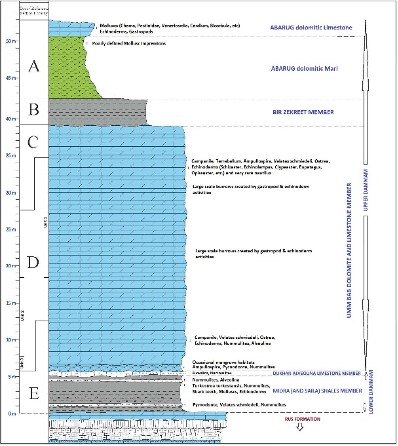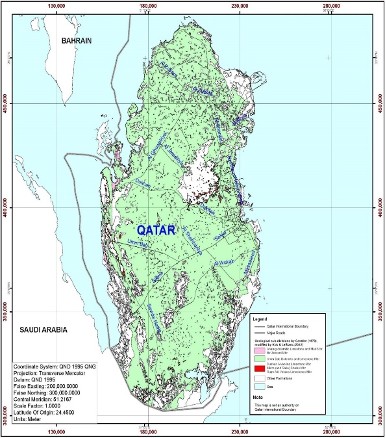Dammam Fm
Type Locality and Naming
Along Dhahran-Al’Alah Road in Saudi Arabia from where this road intersects the rimrock (lat. 26°19'16"N, long. 50°04'50"E) northwest to the Eocene-Miocene contact; Powers (1968). First used by Bramkamp R.A. in an unpublished 1941 report, Saudi Arabia, and formerly described by Powers et al. (1966), Saudi Arabia. Other authors also studied the formation in Bahrain and Qatar, such as Willis (1967) and Cavelier (1970a) respectively.
Synonym:
Reference Section:
A composite section, made up from 5 different Qatar localities is presented for the first time in Fig. 1.
Abarug dolomitic Marl and Limestone Member (Abaruk Bed Fm) – Natural exposure at Lat. 25°26'31.56"N, Long. 50°50'57.56"E; Leblanc (2015a). (Fig. 1 in Abaruk Bed Fm)
Bir Zekreet Member (Bir Zekreet Shale Member Fm) – Natural exposure at Lat. 25°26'32.20"N, Long. 50°51'52.70"E; (Kok, LeBlanc (2012) (Fig. 1, Fig. 2 in Bir Zekreet Shale Member Fm).
Top portion of the Umm Bab Dolomite and Limestone Member – Natural exposure at Naslat Umm Hadidah at Lat. 25°24'5.52"N, Long. 50°53'7.59"E (Fig. 1 in Umm Bab Dolomite and Limestone Member Fm)
Thick portion of the Umm Bab Dolomite and Limestone Member from its base at the QNCC quarry pit – Lat. 25°11’47.87”N, Long. 50°50’15.28”E; LeBlanc (2015a). (Fig. 3, Fig. 4 in Umm Bab Dolomite and Limestone Member Fm)
Natural exposure of the bottom portion of the Umm Bab Dolomite and Limestone Member Fm and full section of the Alveolina Bed Fm, and Midra Shale Member Fm (Midra (and Saila) Shales) - Lat. 25°17'15.79"N, Long. 50°48'12.60"E [1Km east of QP's Fahahil plant; Cavelier (1970a). (Fig. 1, Fig. 2 in Midra Shale Member Fm)
Lithology and Thickness
In type section, Limestone, tan to light brown with interbeds of marl in upper part and shale in the lower part. As per our current knowledge, the maximum thickness of the Dammam Formation in Qatar is 173.9ft (53 metres) (Fig. 1). The deposits composing the Dammam Formation cover about 80% of the surface of the Qatar Territory (Fig. 2). The subdivisions of the Dammam Formation were regrouped into two sets in Qatar by Cavelier (1970a): the Lower Dammam Subformation which includes the two lower members (Midra (and Saila) Shales and the Dukhan Alveolina Limestone), and the Upper Dammam SubFormation composed of the Umm Bab Dolomite and Limestone, Bir Zekreet and Abarug Dolomitic Limestone and Marl members Fig. 1.
[Figure 1: Composite section of the Dammam Formation in Qatar from 5 different localities. See under “Qatar Reference Section” above for the locality coordinates of “A” to “E”. Units 1, 2 and 3 within locality “D” refer to the QNCC quarry section in Fig.]
[Figure 2: Distribution of the Middle Eocene Dammam Formation over Qatar. The red, purple and green colored areas are all part of the Dammam Formation.]
Relationships and Distribution
Lower contact
Rus Fm; contact conformable, taken at sharp change from brown shale above to chalky calcarenite below. The chronological list of current rock units indicates Abaruk Bed Fm
Upper contact
Hadrukh Fm; contact unconformable, marked by clean limestone below and sandy limestone above. The chronological list of current rock units indicates Hasa Gr
Regional extent
GeoJSON
Fossils
In type section, Alveolina cf. A. decipiens SCHWAGER, A. eliptica (SOWERBY) var. flosculina SILVESTRI, and Nummulites spp.
Age
Depositional setting
Additional Information
https://doi.org/10.37819/biosis.001.04.0134 (or via https://sites.google.com/site/leblancjacques)

